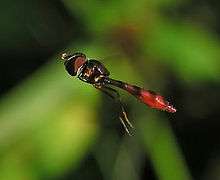Ocyptamus
Ocyptamus is a large and diverse genus of over 200 species of hoverfly mostly found in the Neotropical region.[1][2] It is likely that many of these species will be discovered to be synonyms though many others await description. Also there is some evidence the genus is not monophyletic[3][4] and is paraphyletic with regard to Eosalpingogaster and Toxomerus, and some subgenera have been given full generic status (Hybobathus, Pelecinobaccha, Orphnabaccha, and Pseudoscaeva).[5]
| Ocyptamus | |
|---|---|
 | |
| Ocyptamus cf. fuscipennis | |
| Scientific classification | |
| Kingdom: | |
| Phylum: | |
| Class: | |
| Order: | |
| Family: | |
| Subfamily: | |
| Tribe: | |
| Genus: | Ocyptamus Macquart, 1834 |
Species
Subgenus: Ocyptamus Macquart, 1834
- O. antiphates (Walker, 1849)
- O. calla (Curran, 1941)
- O. cylindricus (Fabricius, 1781)
- O. dimidiatus (Fabricius, 1781)
- O. fasciatus Roeder, 1885
- O. funebris Macquart, 1834
- O. fuscipennis (Say, 1823)
- O. gastrostactus (Wiedemann, 1830)
- O. icarus Reemer, 2010
- O. inca (Curran, 1939)
- O. infuscatus Bigot, 1884
- O. iris (Austen, 1893)
- O. medina (Telford, 1973)
- O. papilionarius (Hull, 1943)
- O. princeps (Hull, 1944)
- O. stolo (Walker, 1852)
- O. tarsalis (Walker, 1836)
Subgenus: Hermesomyia Vockeroth, 1969
- O. wulpianus (Lynch Arribalzaga, 1891)
Subgenus: Pipunculosyrphus Hull, 1937
- O. globiceps (Hull, 1937)
- O. scintillans (Hull, 1943)
- O. tiarella (Hull, 1944)
Subgenus: Mimocalla Hull, 1943
- O. bonariensis (Brethes, 1905)
- O. capitatus (Loew, 1863)
- O. conjunctus (Wiedemann, 1830)
- O. erebus (Hull, 1943)
- O. flata (Hull, 11940)
- O. giganteus (Schiner, 1868)
- O. nymphaea (Hull, 1943)
- O. sargoides (Macquart, 1850)
- O. tristani Zumbado, 2000
- O. willistoni Thompson, 1976
Subgenus: Styxia Hull, 1943
- O. ariela (Hull, 1944)
- O. eblis (Hull, 1943)
Subgenus: Calostigma Shannon, 1927
- O. coreopsis (Hull, 1944)
- O. elnora (Shannon, 1927)
- O. exiguus (Williston, 1888)
- O. ornatipes (Curran, 1927)
- O. striatus (Walker, 1852)
Subgenus: Atylobaccha Hull, 1949
- O. flukiella (Curran, 1941)
See also
Notes
References
- Reemer, M. (2010). "A second survey of Surinam Syrphidae (Diptera):introduction and Syrphinae" (PDF). Tijdschrift voor Entomologie. 153 (2): 163–196. doi:10.1163/22119434-900000295. Archived from the original (PDF) on 2012-09-15. Retrieved 2011-12-24.
- Ximo Mengual; Gunilla Ståhls; Santos Rojo (2008). "First phylogeny of predatory flower flies (Diptera, Syrphidae, Syrphinae) using mitochondrial COI and nuclear 28S rRNA genes: conflict and congruence with the current tribal classification" (PDF). Cladistics. 24 (4): 543–562. doi:10.1111/j.1096-0031.2008.00200.x. hdl:10045/12249. Archived from the original (PDF) on 2009-04-09. Retrieved 2009-10-19.
- Mengual, Ximo (2012). "Is the mega-diverse genus Ocyptamus (Diptera, Syrphidae) monophyletic? Evidence from molecular characters including the secondary structure of 28S rRNA". Molecular Phylogenetics and Evolution. 62 (1): 191–205. doi:10.1016/j.ympev.2011.09.014. PMID 21985963.
- Gonçalves Miranda, Gil Felipe (2011). An overview of the genus Ocyptamus Macquart, 1834, with a revision of the Ocyptamus tristis species group (Doctor of Philosophy thesis). University of Guelph. Archived from the original on 14 July 2012. Retrieved 16 Jan 2012.
- Miranda, G.F.G; Young, A.D.; Locke, M.M.; Marshall, S.A.; Skevington, J.H.; Thompson, F.C. (2013). "Key to the Genera of Nearctic Syrphidae". Canadian Journal of Arthropod Identification. 23. doi:10.3752/cjai.2013.23.
External links
For many photographic examples: https://www.flickr.com/search/?q=ocyptamus&w=all
| Wikimedia Commons has media related to Ocyptamus. |